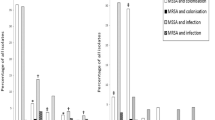Summary
An epidemiological analysis ofStaphylococcus aureus was conducted in a study group of 157 cystic fibrosis patients cultured over a 30-month period. The resultingS. aureus isolates were categorized by bacteriophage type, plasmid profile, and (in some instances) chromosomal restriction fragment pattern of the culture-positive patients withS. aureus (34 of 157) 44% only were sporadically infected while 68% shared identical strains with one or more other patients. Six patients exhibited persistent infection (for up to ten months) which, in three individuals, occurred as cycles of carriage and reappearance. By contributing toward our understanding of the persistence and spread ofS. aureus in cystic fibrosis patients these data should aid in clarifying the role this organism may play in the course of the disease.
Zusammenfassung
Das Auftreten vonStaphylococcus aureus wurde bei 157 Mukoviszidosepatienten über 30 Monate hin analysiert. Dazu wurden dieS. aureus-Isolate nach Lysotyp, Plasmidmuster sowie in einigen Fällen dem Restriktionsmuster ihrer chromosomalen DNS klassifiziert. Danach konnte in 44% aller Patienten, in deren SputaS. aureus nachweisbar war, bei aufeinanderfolgenden Episoden ein Wechsel desS. aureus-Typs beobachtet werden. IdentischeS. aureus-Typen wurden bei 68% der Patienten gefunden, wobei derselbe Typ in bis zu fünf verschiedenen Patienten auftrat. Bei sechs Patienten persistierte derselbeS. aureus-Stamm (bis zu zehn Monate), bei drei unter ihnen war er zwischendurch nicht mehr nachweisbar. Die Ergebnisse weisen auf die Möglichkeit der Ausbreitung vonS. aureus-Stämmen unter Mukoviszidosepatienten hin.
Similar content being viewed by others
References
Bauernfeind, A., Bertele, R. M., Harms, K., Hörl, G., Jungwirth, R., Petermüller, C., Przyklenk, B., Weisslein-Pfister, C. Qualitative and quantitative microbiological analysis of sputa of 102 patients with cystic fibrosis. Infection 15 (1987) 270–277.
Bauernfeind, A., Hörl, G., Przyklenk, B. Microbiologic and therapeutic aspects ofStaphylococcus aureus in cystic fibrosis patients. Scand. J. Gastroenterol. 23 Suppl. 143 (1988) 99–102.
Goering, R. V., Duensing, T. D. Rapid field-inversion gel electrophoresis in combination with a rRNA gene probe in the epidemiological evaluation of staphylococci. J. Clin. Microbiol. 28 (1990) 426–429.
Høiby, N. Microbiology of lung infections in cystic fibrosis patients. Acta Paediatr. Scand. Suppl. 301 (1982) 33–54.
Chartrand, S. A., Marks, M. I. Pulmonary infections in cystic fibrosis: pathogenesis and therapy. In:Pennington, J. E. (ed.): Respiratory Infections: Diagnosis and Management. Raven Press, New York 1988, pp. 276–297.
Geddes, D. M. Antimicrobial therapy againstStaphylococcus aureus, Pseudomonas aeruginosa, andPseudomonas cepacia. Chest 94 (Suppl. 2) (1988) 97S-103S.
Michel, B. C. Antibacterial therapy in cystic fibrosis. A review of the literature published between 1980 and February 1987. Chest 94 (Suppl. 2) (1988) 129S-140S.
Carle, G. F., Frank, M., Olsen, M. V. Electrophoretic separation of large DNA molecules by periodic inversion of the electric field. Science 232 (1986) 65–68.
Smith, P. B. Bacteriophage typing ofStaphylococcus aureus. In:Cohen, J. O. (ed.): The Staphylococci, Wiley-Interscience, New York 1972, pp. 431–441.
Holmes, D. S., Quigley, M. A rapid boiling method for the preparation of bacterial plasmids. Anal. Biochem. 114 (1981) 193–197.
Goering, R. V., Ruff, E. A. Comparative analysis of conjugative plasmids mediating gentamicin resistance inStaphylococcus aureus. Antimicrob. Agents Chemother. 24 (1983) 450–452.
Meyers, J. A., Sanchez, D., Elwell, L. P., Falkow, S. Simple agarose gel electrophoresis method for the identification and characterization of plasmid deoxyribonucleic acid. J. Bacteriol. 127 (1976) 1529–1537.
Huang, N. N., Schidlow, D. V., Szatrowski, T. H., Palmer, J., Laraya-Cuasay, L. R., Yueng, W. et al.: Clinical feature, survival rate, and prognostic factors in young adults with cystic fibrosis. Am. J. Med. 82 (1987) 871–879.
Albus, A., Fournier, J.-M., Wolz, C., Boutonnier, A., Ranke, M., Høiby, N. et al.:Staphylococcus aureus capsular types and antibody response to lung infection in patients with cystic fibrosis. J. Clin. Microbiol. 26 (1988) 2505–2509.
Author information
Authors and Affiliations
Rights and permissions
About this article
Cite this article
Goering, R.V., Bauernfeind, A., Przyklenk, B. et al. Staphylococcus aureus in patients with cystic fibrosis: An epidemiological analysis using a combination of traditional and molecular methods. Infection 18, 57–60 (1990). https://doi.org/10.1007/BF01644187
Issue Date:
DOI: https://doi.org/10.1007/BF01644187




